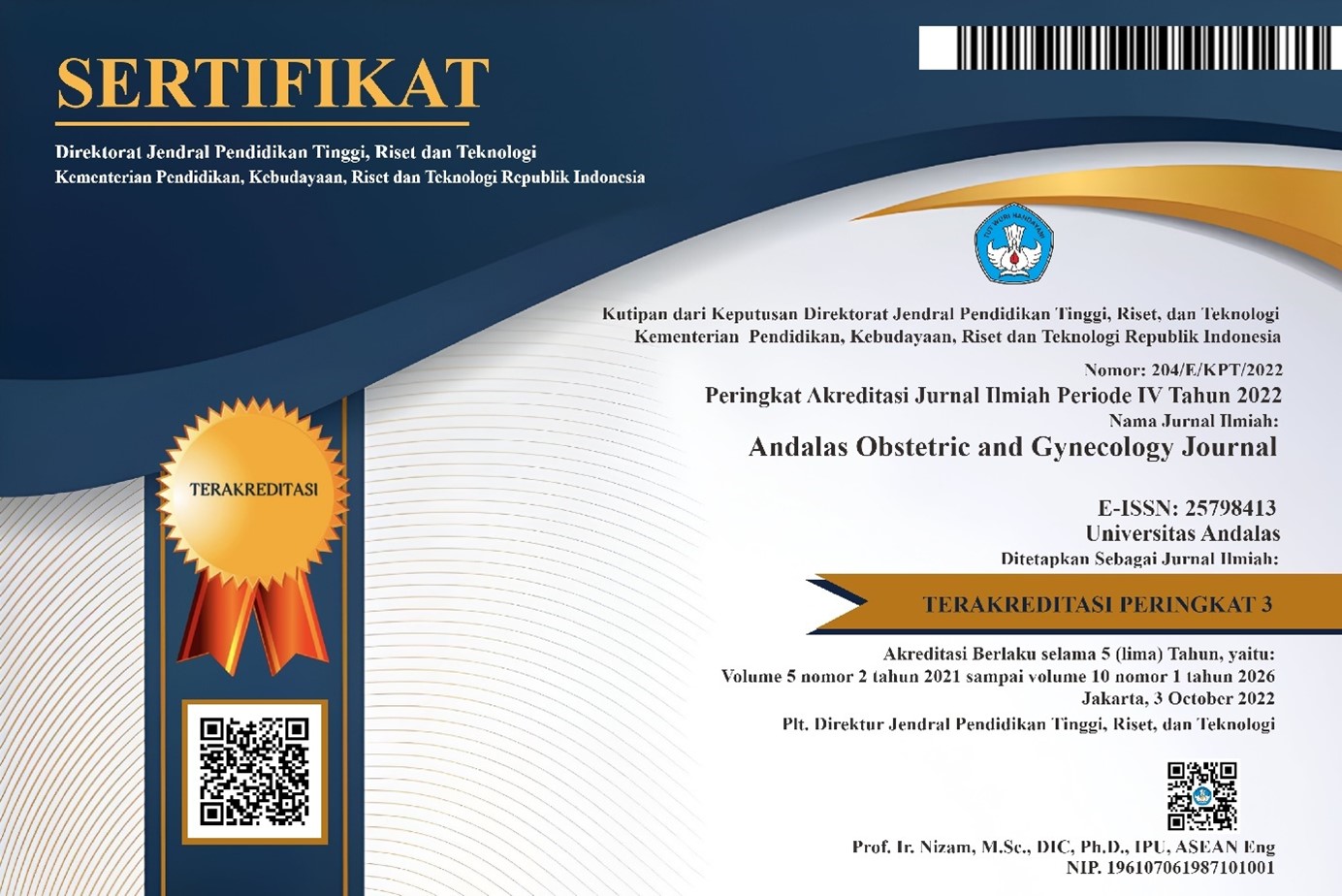Early Haemorrhage Postpartum (HPP); With Complication Disseminated Intravascular Coagulation, Sepsis, Acute Kidney Injury
DOI:
https://doi.org/10.25077/aoj.8.1.632-641.2024Keywords:
preeclampsia, early onset, late onset, normal pregnancy, urinary Cystatin-CAbstract
Background : Hemorrhage Postpartum (HPP) is the leading cause of maternal death worldwide with an incidence of 5%-10% of all deliveries. 70% of cases of HPP are caused by atony of the uterus. If HPP is not handled properly, it will cause worsening of the patient's condition which causes various multiorgan complications.
Objectives : To discuss the management of HPP cases complicated by DIC, sepsis and AKI.
Method : case report.
Case : A female patient, 36 years old, was referred from a private hospital to PONEK RSUP Dr. M. Djamil Padang with a diagnosis of decreased consciousness ec suspected sepsis in post SCTPP oi used SC 2x + post relaparotomy oi bleeding subfascia + moderate anemia. After surgery, the patient looked pale and the hemoglobin was 7, then relaparotomy was done and done B-lynch oi uterine hypotony. After relaparotomy, the patient experienced worsening then referred to the hospital. The patient arrives with hipovolemic shock + AKI + Sepsis + DIC , then the condition improvement is carried out in ROI and hysterectomy relaparotomy is performed. The patient has worsened, maximum treatment has been carried out from the intersivist, but the patient's condition continues to worsen and eventually dies.
Conclusion : Early diagnosis and rapid treatment through a multidisciplinary team and the availability of an Intensive Care Unit (ICU) can prevent complications and reduce morbidity and mortality.
References
Cunningham et al. Williams Obstetric. 25th Edition. http://t.me/ebookers; 2018
Kementerian Kesehatan RI. Profil Kesehatan Indonesia 2020. Jakarta; 2020.
Queensland Health. Primary Postpartum Haemorrhage. Queensland Clinical Guideline 2018 march MN18.1-V7-R23
The Society of Obstetricians and Gynaecologists of Canada. Alarm Course Manual 22nd Edition. SOGC. 2016; 16 :1-37.
Rani, P.Reddi, Begum Jasmina.Recent Advances in the Management of Major Post Partum Hemorrhage-a review. Journal of Clinical & Diagnostic Research 2017 Feb vol 11 (2) QE01-QE05
WHO. WHO Guideline for the Management Postpartum Hemorrhage and Retain Placenta. World Health Organization; 2009
Begum Jasmina, et.all. B-Lynch; a Technique for Uterine Conservation or Deformation? A Case Repport with Literature Review. International Journal of Gynecology and Obstetric 2014 apr, vol-8(4): OD01-0D03
FIGO. Prevention and Treatment of Post Partum Hemorrhage in Low-resource setting. International Journal of Gynecology and Obstetric 117 (2012) 108-118
POGI. Pedoman Nasional Pelayanan KesehatanPerdarahan Pasca-Salin. Perkumpulan Obstetri dan Ginekologi Indonesia Himpunan kedokteran Fetomaternal 2016
Karkata MK, Kristanto H. Panduan Penatalaksanaan Kasus Obstetri. Himpunan Kedokteran Fetomaternal POGI. 2012; 11 : 160-183
Hoelman, Mickael B., et.all. PANDUAN SDGs untuk Pemerintah Daerah (Kota dan Kabupaten) dan Pemangku Kepentingan Daerah. International NGO Forum on Indonesian Development; 2015
Shakur, et.all. The Woman Trial (World Maternal Antifibrinolytic Trial); Tranexamic acid for the Treatment of Postpartum Haemorrhage; an International Randomised, Double Blind placebo Controlled Trial. UK: Biomed Central: 2010
ACOG. Clinical Management for Obstetrician-Gynecologist: Postpartum Haemorrhage. ACOG Practice Buletin vol 130, no. 4, October 2017
NHS. Obstetric Haemorrhage – Clinical Guideline. Royal Cornwall Hospitals. NHS Trust. V2.1 2018
Al Banna, Weaam Nabil. Postpartum Haemorrhage and How to be Managed. EC Gynaecology 5.6 (2017) 223-229
The RANZCOG. Management of Postpartum Haemorrhage (PPH). The Royal Australian and New Zealand College of Obstetrician and Gynecologist: 2017
Balogoun-Lynch Christopher and Whitelaw Naomi. The Surgical Management of Postpartum Haemorrhage. Cambridge University. Fetal and Maternal Medicine Review 2006; 17:2 105-123
E. Mavrides, etal. Prevention and Management of Postpartum Haemorrhage. BJOG 2016;124:e126-e149
Edhi, et al. Postpartum Haemorrhage: Cause and Management. BMC Research Notes 2013, 6:236.
Singer, M. et al. The third international consensus definitions for sepsis and septic shock(sepsis-3). JAMA - J. Am. Med. Assoc. 315, 801–810 (2016).
Mehta RL, Kellum JA, Shah SV, Molitoris BA, Ronco C et al. Acute kidney Injury Network: report of an initiative to improve outcomes in acute kidney injury. Critical care2017,11:R31
Thachil, J. & Toh, C. H. Disseminated intravascular coagulation in obstetric disorders and its acute haematological management. Blood Rev. 23, 167–176 (2019).
Al Wattar et al. Management of Obstetric Postpartum Hemorrhage: a National Service Evaluation of Current Practice in the UK. Risk Management and Healthcare Policy. 11 January 2017.
Yamashita Y, et.all. Intra-aortic Balloon Occlusion without Flouroscopy for Life-threatening Post-partum Haemorrhage. De Gruyter. Med. 2016;5(1): 19- 22
Himmelfarb J, Joannidis M, Molitoris B, Schietz M, Okusa MD, Warnock D et al. Evaluation and Initial Management of Acute Kidney Injury. Clin J Am Soc Nephrol 3:962-967,2018
Downloads
Published
Issue
Section
License
Copyright (c) 2024 Rizki Oktavian, Roza Sriyanti, Emilzon Taslim

This work is licensed under a Creative Commons Attribution 4.0 International License.
Copyright
Authors who publish with this journal agree to the following terms:
- Authors retain the copyright of published articles and grant the journal right of first publication with the work simultaneously licensed under a Creative Commons Attribution 4.0 International License that allows others to share the work with an acknowledgment of the work's authorship and initial publication in this journal.
- Authors are able to enter into separate, additional contractual arrangements for the non-exclusive distribution of the journal's published version of the work (e.g., post it to an institutional repository or publish it in a book), with an acknowledgment of its initial publication in this journal.
- Authors are permitted and encouraged to post their work online (e.g., in institutional repositories or on their website) prior to and during the submission process, as it can lead to productive exchanges, as well as earlier and greater citation of published work (See The Effect of Open Access).
License:
Andalas Obstetrics and Gynecology Journal (AOJ) is published under the terms of the Creative Commons Attribution 4.0 International License. This license permits anyone to copy and redistribute this material in any form or format, compose, modify, and make derivatives of this material for any purpose, including commercial purposes, as long as they credit the author for the original work.







